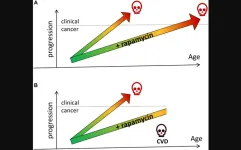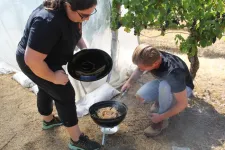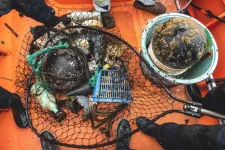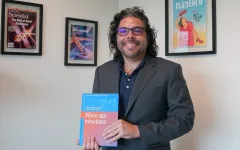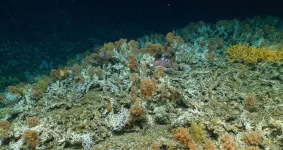Cancer prevention with rapamycin
2023-04-17
(Press-News.org)
“[...] long-term treatment with rapamycin slows down aging, a major risk factor for cancer [...]”
BUFFALO, NY- April 17, 2023 – A new research perspective was published in Oncotarget's Volume 14 on April 14, 2023, entitled, “Cancer prevention with rapamycin.”
The mTOR (Target of Rapamycin) pathway is involved in both cancer and aging. Furthermore, common cancers are age-related diseases, and their incidence increases exponentially with age. In his new research perspective, Mikhail V. Blagosklonny, M.D., Ph.D., from Roswell Park Comprehensive Cancer Center discusses rapamycin and other rapalogs and their potential to delay cancer by targeting pre-cancerous cells and slowing down organismal aging.
“Rapamycin (sirolimus) and other rapalogs (everolimus) are anti-cancer and anti-aging drugs, which delay cancer by directly targeting pre-cancerous cells and, indirectly, by slowing down organism aging.”
Cancer is an age-related disease and, figuratively, by slowing down time (and aging), rapamycin may delay cancer. In several dozen murine models, rapamycin robustly and reproducibly prevents cancer. Rapamycin slows cell proliferation and tumor progression, thus delaying the onset of cancer in carcinogen-treated, genetically cancer-prone and normal mice. Data on the use of rapamycin and everolimus in organ-transplant patients are consistent with their cancer-preventive effects. Treatment with rapamycin was proposed to prevent lung cancer in smokers and former smokers. Clinical trials in high-risk populations are warranted.
“Currently, an increasing number of healthy people use rapamycin off-label to slow down aging. Perhaps in ten or twenty years from now, data will accumulate for retrospective analysis of cancer-prevention with rapamycin in humans.”
Read the full research perspective: DOI: https://doi.org/10.18632/oncotarget.28410
Correspondence to: Mikhail V. Blagosklonny
Email: Blagosklonny@oncotarget.com, Blagosklonny@rapalogs.com
Keywords: chemoprevention, lung, rapamycin, aging, cancer
About Oncotarget: Oncotarget (a primarily oncology-focused, peer-reviewed, open access journal) aims to maximize research impact through insightful peer-review; eliminate borders between specialties by linking different fields of oncology, cancer research and biomedical sciences; and foster application of basic and clinical science.
To learn more about Oncotarget, visit Oncotarget.com and connect with us on social media:
Twitter
Facebook
YouTube
Instagram
LinkedIn
Pinterest
LabTube
Soundcloud
Click here to subscribe to Oncotarget publication updates.
For media inquiries, please contact: media@impactjournals.com.
Oncotarget Journal Office
6666 East Quaker Str., Suite 1A
Orchard Park, NY 14127
Phone: 1-800-922-0957 (option 2)
###
END
ELSE PRESS RELEASES FROM THIS DATE:
2023-04-17
It epitomizes the Great Plains in spirit and in form: a 2,000-pound tank on hooves, cloaked in shaggy winter-tested coat, capped by horns acting as warning and weapon.
Even its scientific name, Bison bison bison, seems to conjure an echo worthy of its majesty. Still, the implacable profile of the Plains bison — the national mammal of the United States and largest on the continent — belies the vulnerability in its history, which saw its legions decimated from tens of millions to just a few hundred in the span of a few colonial centuries.
Conservation efforts have pushed its number back to roughly 20,000, and its status from endangered ...
2023-04-17
CORVALLIS, Ore. – Oregon State University researchers have discovered a new class of compounds that contributes to the ashy or smokey flavors in wine made with grapes exposed to wildfire smoke.
This development is significant for winemakers who have struggled to combat the impact of smoke on grapes at a time when climate change is leading to an increase in the number and severity of wildfires, the researchers said.
“These findings provide new avenues for research to understand and prevent smoke taint in grapes,” said Elizabeth Tomasino, an associate professor of enology ...
2023-04-17
The high seas have been colonized by a surprising number of coastal marine invertebrate species, which can now survive and reproduce in the open ocean, contributing strongly to the floating community composition. This finding was published today in Nature Ecology and Evolution by a team of researchers led by the Smithsonian Environmental Research Center (SERC) and the University of Hawai‘i (UH) at Mānoa.
The researchers found coastal species, representing diverse taxonomic groups and life history traits, in the eastern North Pacific Subtropical Gyre on over 70 percent of the plastic debris ...
2023-04-17
UCF Researchers Create Digital Map of Sympathetic Nervous System
A team of UCF College of Medicine researchers has created a digital topographical map of the cardiac sympathetic neural network, the region that controls the body’s heart rate and its “fight-or-flight” response. They hope this map will eventually serve as a guide to treat cardiovascular conditions using bioelectronic devices.
The study, led by Dr. Zixi Jack Cheng, a neuro-cardiovascular scientist, was published in the Scientific Reports journal ...
2023-04-17
Climate change may be linked to an increase in the emergence of new pandemics, according to a new book published by an internationally recognized College of Medicine microbiologist.
Dr. Salvador Almagro-Moreno has teamed with fellow molecular biologist Dr. Stefan Pukatzki of City University New York – CUNY, to author the book titled Vibro spp. Infections, recently published by Springer Nature and includes the latest scientific research articles in this field from experts worldwide.
The book examines the factors associated with ...
2023-04-17
(MEMPHIS, Tenn. – April 17, 2023) Sickle cell disease (SCD) is a serious blood disorder affecting millions of people, primarily those of African descent. A mutation in the gene that encodes a subunit of the oxygen-carrying molecule, hemoglobin, causes the disease. Scientists at St. Jude Children’s Research Hospital and the Broad Institute of MIT and Harvard showed a precise genome editing approach, prime editing, can change mutated hemoglobin genes back to their normal form in SCD patient cells, which restores ...
2023-04-17
Reston, VA—The Society of Nuclear Medicine and Molecular Imaging (SNMMI) and 10 other professional societies have issued new appropriate use criteria (AUC) for lymphoscintigraphy in sentinel node mapping and lymphedema/lipedema. The criteria, summarized in the April issue of The Journal of Nuclear Medicine (JNM), include a list of relevant clinical scenarios, a systematic review of evidence in the literature, and a systematic analysis of available evidence, followed by grading each of the clinical scenarios.
Sentinel lymph nodes ...
2023-04-17
Renowned physicist, engineer and entrepreneur Eli Yablonovitch will visit Utah State University on April 25 for two lectures about his work in the electrical and computer engineering field.
Yablonovitch, who is currently a professor emeritus at the University of California Berkeley, will present lectures on controlling carbon intake as a solution to climate change and on physics and optimization in the engineering world. The lectures will take place on April 25, at 1 pm and 3 pm respectively. An RSVP form can be found on this webpage. All are encouraged to attend.
“Having Dr. Yablonovitch travel to speak to us is a great honor and a great opportunity for us ...
2023-04-17
17 April 2023 - Galápagos, Ecuador – Scientists have discovered extensive, ancient deep-sea coral reefs within the Galápagos Marine Reserve (GMR) – the first of their kind ever to be documented inside the marine protected area (MPA) since it was established in 1998. The first reef observed was found at 400-600m (1,310-1,970 feet) depth at the summit of a previously unmapped seamount in the central part of the archipelago and supports a breathtaking mix of deep marine life.
Cresting the ridge of a submerged volcano, and stretching over several kilometers, the impressive reef structure was first recorded by Dr. Michelle ...
2023-04-17
A new discovery by researchers at the University of Warwick could help stop bacteria being contaminated with viruses, reducing disruption and decreasing costs in industry and research.
Bacteria are routinely used in biological and biomedical research. They are crucial in food production and emerging industrial biotechnologies, where bacterial ‘factories’ can be used to produce new materials, medicines and chemicals. Industrial biotechnology uses microorganisms as alternatives to traditional ...
LAST 30 PRESS RELEASES:
[Press-News.org] Cancer prevention with rapamycin
